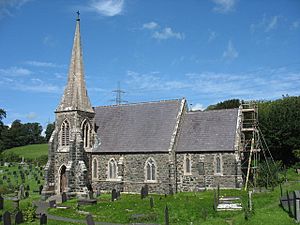St Mary's Church, Llanfairpwllgwyngyll facts for kids
Quick facts for kids St Mary's Church |
|
|---|---|
| Church of St Mary | |
 |
|
| Denomination | Church in Wales |
| Previous denomination | Church of England |
| History | |
| Status | active |
| Dedication | Virgin Mary |
| Consecrated | 1853 |
| Architecture | |
| Heritage designation | Grade II |
| Designated | 1998 |
| Years built | 1853 |
| Administration | |
| Parish | Llanfairpwll & Llanddaniel-fab |
| Diocese | Diocese of Bangor |
St Mary's Church is a special church in a village called Llanfairpwllgwyngyll, on an island in Wales called Anglesey. It's part of the Church in Wales. This church was built a long time ago, in 1853, to be a place of worship for the people living there. It's also a 'Grade II-listed building,' which means it's an important historical building that needs to be protected.
Contents
The Church's Story
Long ago, even before the current St Mary's Church, there was an older church on the same spot. It was also named after the Virgin Mary. In 1853, people decided to rebuild the old church. They used strong stone and spent about £950 on the project.
The new church was officially opened and blessed by the Bishop of Bangor in the same year. Many of the old church's decorations and furniture were replaced. However, the original baptismal font, which is a special bowl used for baptisms, was kept and moved into the new building.
Beautiful Stained Glass Windows
Over time, the church's plain windows were replaced with colorful stained glass windows. These beautiful windows were given by different people who wanted to help the church.
The window at the east side of the church shows scenes from the Bible. It was dedicated in 1876 to Henry Paget, 1st Marquess of Anglesey. The window on the west side shows Jesus and his Twelve Apostles. This one was dedicated in 1876 to Sir Robert Waller Otway, 1st Baronet. More windows on the north and south sides were added in 1900 and 1906.
War Graves in the Churchyard
The churchyard, which is the area around the church, is also a special place. It holds five Commonwealth war graves. These are the resting places of soldiers and sailors who died serving their country.
Two of the graves belong to soldiers from the Royal Welch Fusiliers and one to a Merchant sailor from World War I. The other two graves are for a Merchant sailor and a Royal Navy sailor from World War II.
Why St Mary's is a Listed Building
In 1998, St Mary's Church was given a special status: Grade II-listed. This means it's recognized as an important building with historical or architectural value. It was noted as a great example of a small Gothic Revival church. This style is known for its clear shapes and detailed designs.
The Village with a Long Name
The village where St Mary's Church stands is famous for its incredibly long name: Llanfairpwllgwyngyllgogerychwyrndrobwllllantysiliogogogoch. The village itself is named after St Mary's Church.
The first part of the name, "Llanfairpwllgwyngyll," means "The Church of St Mary at Pwllgwyngyll." Pwllgwyngyll refers to "the white hazel pool." The very long version of the name was created in the 1800s to help promote the village and make it famous.
The second part of the long name, "gogerychwyrndrobwllllantysiliogogogoch," means "near the rapid whirlpool, near St Tysilio's red cave." This part refers to another local area and its features.

